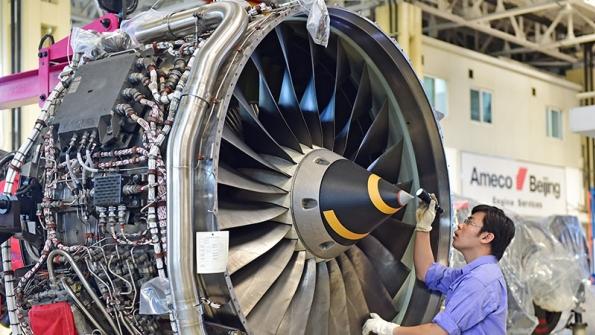Assessing Phantom Overhauls | まだ見えぬエンジンオーバーホール業界の今後

In September of this year, Ameco Beijing became the 10th member of the GTF MRO network. The Air China-Lufthansa Technik joint venture will repair the PW1100G-JM powering A320neo family from its engine shop in Beijing.
今後数年間のエンジンアフターマーケットの動向を左右する不確実性のひとつは、ショップ整備を受ける寿命半ばのエンジンの数だ。
コンサルティング会社IBA社のシニアエンジンアナリスト・David Archer氏はEngine Yearbook誌に対し、「これにより多くのオペレーターやリース会社が重大な判断を迫られており、エンジンの使用期間と需要回復のタイミングが主な判断基準となる」と語った。
IBA社は、エンジン整備の需要回復について3つのシナリオを想定した。最も楽観的なシナリオでは2024年にはコロナ危機以前のレベルに回復するが、最悪のシナリオでは2020年代末にかけて需要の低迷が続く。
ショップ整備を実施するかどうかの判断基準として有用な指標は、初回整備・ショップ整備2回目・同3回目のエンジンの年度別構成比率だ。
たとえば、コロナ危機以前にIBA社が出していた予想では、ショップ整備総数の51%を整備2回目・3回目のエンジンが占めていたが、今年50%以上落ち込んだショップ整備の大半をこれらが占めていると同社は予想している。なお、この新たな予想には貨物機の追加需要分も織り込み済だ。
2021年には、ショップ整備2回目・3回目のエンジンが占める割合は45%に低下し、ここで底を打って翌年は改善される可能性もある。これ以降は、これらのエンジンが占める割合は増加傾向に入り、2025年には60%近くを占めることになるだろう。
この頃には、航空旅客数は2019年のレベルを上回るとIATAは予想しており、そうであれば、航空会社も老朽化したエンジンに対して再度オーバーホールを実施すると考えられる。
しかし、もしそうならなかった場合は、エンジンオーバーホール業者は「失われた10年」に直面することになるか、少なくとも以前の想定よりもはるかに少ないパイを奪い合うことになる。
以上は、Alex DerberがInside MRO誌いた記事です。Aviation Week Intelligence Network (AWIN) のメンバーシップにご登録いただくと、開発プログラムやフリートの情報、会社や連絡先データベースへのアクセスが可能になり、新たなビジネスの発見やマーケット動向を把握することができます。貴社向けにカスタマイズされた製品デモをリクエスト。
One of many uncertainties about how the engine aftermarket will develop over the next few years concerns the number of mid-life and older engines that will undergo another shop visit.
“This is a decision to which many operators and lessors will be giving serious consideration, key factors being the asset’s maturity and whether or not a swift recovery is anticipated,” David Archer, senior engine analyst for consultancy IBA tells the Engine Yearbook.
IBA has estimated how demand may recover under three scenarios, according to the most optimistic of which shop visits catch up with pre-Covid projections near 2024, while its downside scenario would see demand depressed for almost the whole decade.
A useful guide to which visits may or may not occur is the composition of shop visit demand each year, by percentage of first-, second- and third-run engines.
For example, in 2020 51% of shop visits were (pre-Covid) projected by IBA to be for second- or third-run engines, and these likely constitute the bulk of the more than 50% drop-off in shop visit numbers that the consultancy forecasts for this year, even accounting for some extra maintenance demand from cargo carriers.
Second- and third-run engines dip to 45% of shop visit numbers for 2021, which may mean that the engine aftermarket does somewhat better than the grimmer projections for next year, but thereafter their share climbs steadily to reach almost 60% of projected visits by 2025.
At that point, IATA predicts that passenger traffic will exceed 2019 levels, in which case airlines may well be willing to push older engines through another overhaul.
If not, however, engine overhaul shops could be facing a lost decade, or at least one in which they share a much smaller pie than previously envisaged.